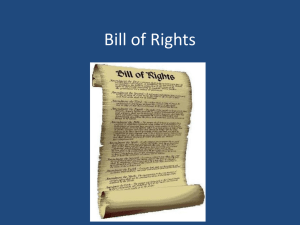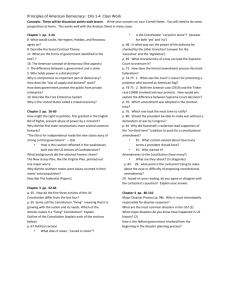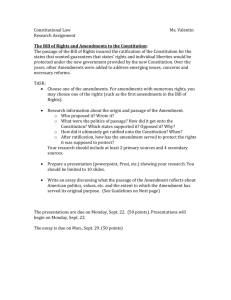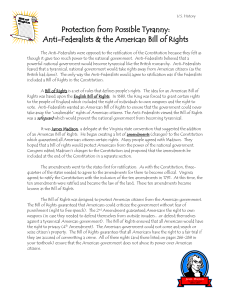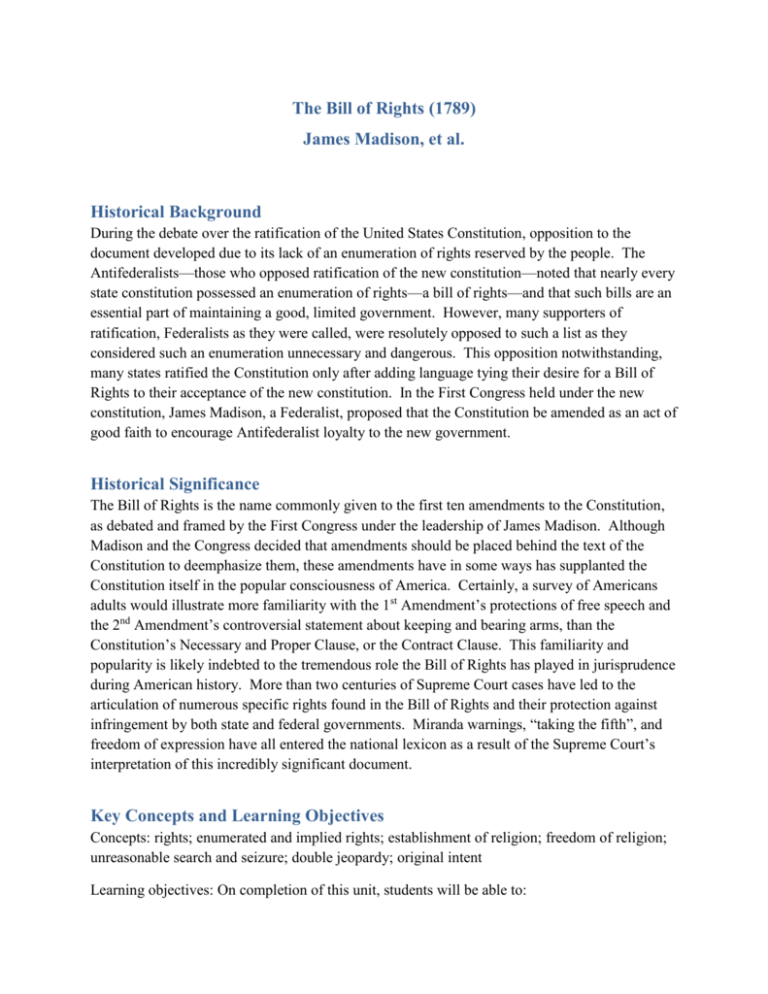
The Bill of Rights (1789)
James Madison, et al.
Historical Background
During the debate over the ratification of the United States Constitution, opposition to the
document developed due to its lack of an enumeration of rights reserved by the people. The
Antifederalists—those who opposed ratification of the new constitution—noted that nearly every
state constitution possessed an enumeration of rights—a bill of rights—and that such bills are an
essential part of maintaining a good, limited government. However, many supporters of
ratification, Federalists as they were called, were resolutely opposed to such a list as they
considered such an enumeration unnecessary and dangerous. This opposition notwithstanding,
many states ratified the Constitution only after adding language tying their desire for a Bill of
Rights to their acceptance of the new constitution. In the First Congress held under the new
constitution, James Madison, a Federalist, proposed that the Constitution be amended as an act of
good faith to encourage Antifederalist loyalty to the new government.
Historical Significance
The Bill of Rights is the name commonly given to the first ten amendments to the Constitution,
as debated and framed by the First Congress under the leadership of James Madison. Although
Madison and the Congress decided that amendments should be placed behind the text of the
Constitution to deemphasize them, these amendments have in some ways has supplanted the
Constitution itself in the popular consciousness of America. Certainly, a survey of Americans
adults would illustrate more familiarity with the 1st Amendment’s protections of free speech and
the 2nd Amendment’s controversial statement about keeping and bearing arms, than the
Constitution’s Necessary and Proper Clause, or the Contract Clause. This familiarity and
popularity is likely indebted to the tremendous role the Bill of Rights has played in jurisprudence
during American history. More than two centuries of Supreme Court cases have led to the
articulation of numerous specific rights found in the Bill of Rights and their protection against
infringement by both state and federal governments. Miranda warnings, “taking the fifth”, and
freedom of expression have all entered the national lexicon as a result of the Supreme Court’s
interpretation of this incredibly significant document.
Key Concepts and Learning Objectives
Concepts: rights; enumerated and implied rights; establishment of religion; freedom of religion;
unreasonable search and seizure; double jeopardy; original intent
Learning objectives: On completion of this unit, students will be able to:
describe the process for amending the Constitution;
describe and evaluate arguments for and against enumerating citizens’ rights in a
constitution;
describe and explain why interpretation of individual amendments in the Bill of Rights is
significant and controversial (the teacher could choose which right to investigate based
on student interest, teacher comfort);
synthesize or create their own conception of a fundamental Bill of Rights for the nation
(or a smaller community such as school, city, or state) explaining why the rights they
chose to include are essential.
Questions to Explore
What is a right? Why are rights so significant in our lives?
Examining the Bill of Rights provides fertile ground for considering the particular rights listed in
this document. Are the rights enumerated here timeless and inalienable rights possessed by all
people? Or are these rights limited either in application (to only Americans?) or in time (only
during the Founding)? In either case, explain your answer.
The First Amendment and the Second Amendment in particular have posed interpretive
problems for judges, politicians and ordinary citizens. In general, how should we interpret
constitutional provisions recognizing certain rights? Should we pay attention mostly to what the
people who originally passed these amendments thought, should we care more about our present
day needs, or should we balance these considerations in some way? Explain your answer using
one of the two listed amendments as an example.
The First Amendment has been interpreted as creating a “wall of separation” between church and
state. To what extent do you think that interpretation is accurate based on your reading of the
First Amendment? Is there a tension between the ideals of separation of church and state and of
freedom of religion? How might these concepts be balanced or defined so as to minimize such
conflicts?
When and why is freedom of speech good? When and why is it dangerous? What different
arguments can be made to defend this freedom, and what limits, if any, do these arguments imply
on the appropriate extent of speech or expression that should be allowed? For example, many
people think that so-called hate speech should not be tolerated, while others argue that all bans
on speech are unconstitutional—that the First Amendment creates a marketplace of ideas that
requires no government restriction of messages, no matter how hateful or offensive they may be
to the rest of us. Similar arguments have arisen over speech or visual images that involve
obscenity. How should these forms of expression be handled, based on your reading of the First
Amendment?

